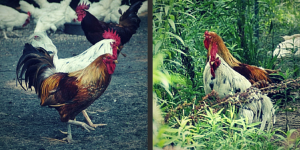For Memorial Day weekend, here’s another excerpt from my as-yet unpublished memoir of the sanctuary’s decade on the Delmarva Peninsula, which began when we found a rooster by the side of the road in 2000 and ended when we relocated the sanctuary to Vermont in order to both have more room for rescued roosters and begin offering refuge to survivors of dairying. In this installment, elderly best friends Rocco and DeWayne, along with 22 other roosters, descend on the sanctuary, changing everything.
The sanctuary population bloomed in bursts, each round of immigration bringing an influx of unfamiliar feathers. The roosters who blew into town in our second year changed the atmosphere forever and for the better.
It all began, as so many sanctuary stories do, with a frantic voice on the other end of the telephone. Carol Morton was a retired humane officer who had routinely taken home confiscated chickens rather than letting the county euthanize them. She’d always been able to find homes for hens, but found roosters impossible to place, due to the stereotypes that even operators of sanctuaries believed about them.
Over the years, she’d accumulated two dozen birds. Some had been seized in cockfighting busts, some from abusive or neglectful homes, and a few from what she described as “a 4-H project gone horribly wrong.” They all lived together on a big patch of rented land, sleeping in the trees and going into an open barn in inclement weather. But now the owners wanted the land back. Carol needed to be off the property at the end of the month. She had found housing for herself in Florida but had no luck at all finding homes for any of the birds. Every other sanctuary said that they didn’t have room. Most went on to say that they didn’t accept roosters anyway.
“Why not?”
“They say that that roosters fight. I told them that these guys have been living together for years. They won’t listen.”
I don’t like to be tricked by stereotypes. I remembered how my own received ideas about roosters had interfered with my ability to see Viktor in those first few days after learning that he was male. I thought about gentle, overweight Romeo and his seven or eleven girlfriends confounding the notion that females prefer dominant, aggressive males. I thought about sunny Chickweed, cranky Fidel, bashful Billy, affectionate Olive, helpful Turtle, courageous Che, and the spectrum of other rooster personalities out in our yards.
On the other hand, some people might say that those denatured “broiler” chickens were atypical, that the gamecocks and other breeds of rooster Carol proposed to bring to the sanctuary would demonstrate the natural aggressiveness that led to the sport of cockfighting. Would these birds fight each other? Would they attack our birds? Carol assured us they would not.
“Please. I couldn’t bear to euthanize them. They don’t deserve to die.” I heard Carol begin to cry.
“Okay,” I said shakily, “give me a few days to work out how we can do this.”
Always the more sensible of the two of us, Miriam worked out the logistics of my rash decision. We’d need that new coop and yard we’d been planning to set up for the broiler hens. Where would the money come from? Karen Davis of United Poultry Concerns found us a generous donor to pay for the coop and fencing materials. Carol promised to kick in some cash to cover the extra feed we’d need. We got busy clearing brush and erecting fences, which we had finally figured out how to do together without arguing.
The refugee roosters arrived on Memorial Day. Looking at the colorful crowing birds crammed into a motley collection of cages and carriers in Carol’s rattletrap pickup truck, my confidence ebbed. What if we’d made a mistake? What if they fought each other or attacked the broiler roosters? They were used to more land, to sleeping in trees. What if they flew away or disappeared into the woods?
Until then, the only roosters at the sanctuary had been the big white birds bred by the poultry industry. Now, all at once, here were two dozen multicolored roosters of various shapes and sizes, many of whom had vivid plumage. One bird, who we came to call Cocoa Puff, had such lushly colorful fluffy head-feathers that he looked like he belonged in a tropical rainforest. When Fanny and her friends from the egg factory first caught sight of him, they stopped what they were doing and stood in a line along the fence, gaping at the sight. Some of their beaks hung open, as if they were slack-jawed with surprise.
Miriam and I were astonished too. None of our fears came to fruition. The new roosters settled in with remarkably little fuss, some choosing to camp out in the coop and others electing to take to the trees. We had never seen such a thing. Most people haven’t. In all of our years on the Delmarva, the one thing about our sanctuary that most consistently enchanted visitors was the sight of chickens roosting in the trees.
The ease with which we were able to integrate the 24 roosters shunned by every other sanctuary led us to question everything… including the notion that roosters used in cockfighting are so incorrigibly aggressive that they must be euthanized. The next summer we would successfully test a method of rehabilitating and integrating former fighting roosters into our flocks, a method that we and other sanctuaries still use today.





Not only did you save those 24 handsome roosters, but indirectly through sharing your method of rehabilitating former fighting roosters, you have saved thousands of others around the world. I live in suburbia so sadly the Council won’t allow roosters. We do have 4 ex-batt hens, and 2 male Muscovies that no-one wanted. It’s so lovely to have them in our yard.
Bede Carmody, A Poultry Place, NSW, Australia